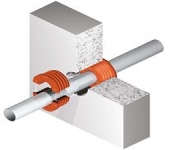
|
|
| home | contact | team t&d | group websites | markets | exports | blog |
 |
|
Sealing Cable Entry Points
 CSD RISE Duct & Multi-Cable Transit Sealing Systems
CSD RISE Duct & Multi-Cable Transit Sealing Systems
RISE Duct & Multi-Cable Transit Sealing SystemsCSD RISE duct seal systems provide excellent flood protection against leak paths in cable and pipe service entry points e.g. ventilation ducts, electricity, data, phone cables and utility pipes. Using the most advanced product range for water tight sealing for cable and pipe entries the CSD RISE duct seal is a multi-cable and pipe transit sealing system which provides an effective and simple solution to watertight duct sealing requirements.
RISE consists of two components : rubber insert sleeves, used to guarantee cable separation and as a backing for the sealant layer and FIWA or NOFIRNO sealant : a high quality silicone based, water repellant sealant which consequently makes the duct sealing system. The elasticity and high bonding strength of quality sealant used by CSD offers a flexible seal which resists movement, shock, vibration and protection against water ingress to high pressure in excess of 4 BAR.
SLIPSIL Duct Plug
SLIPSIL sealing plugs are designed to seal cables and metallic and plastic pipes against the ingress of flood water at pressures of 2.5 BAR. Sealing plugs consist of 2 equal parts that allows them to be inserted after all cables and pipes in a conduit are installed. The flange of the sealing plug is designed in a way that even after installation they are easily recognisable. The sealing plugs have a special profiling, the serrated profiles at the outside have an interspacing and are levelled and the inner ribs flattened and interconnected. All tested under severe conditions, suitable for wide ranging industries and use in hazardous areas - water tight sealing for cable and pipe entries available for use in "A" Class, "H" Class and Watertight Boundaries.
Installation Method for Slipsil Duct Plug Sealing Systems:
| - |
Treat the inside wall of the conduit sleeve with CSD lubricant along a distance which approximately corresponds with the length of the Slipsil sealing plug. |
 |
| - |
The inside and outside surfaces of both segments of the Slipsil sealing plug are then treated with CSD lubricant. |
 |
| - |
Both segments of the Slipsil sealing plug are placed around the ducted pipe and then pushed into the conduit sleeve as far as the first serration. |
 |
| - |
Then both segments of the Slipsil sealing plug are pushed by hand evenly -serration by serration- further into the conduit sleeve. |
 |
| - |
The flanged edge of the Slipsil sealing plug must be flush against the front side of the conduit sleeve. |
 |
| - |
For fire rated penetrations Slipsil sealing plugs have to be inserted in both ends of the sleeve. Insulation of the conduit sleeve and/or ducted pipe only at one side of the partition. Please refer to the detailed drawings which are a part of the Type Approval Certificates. |
 |






























